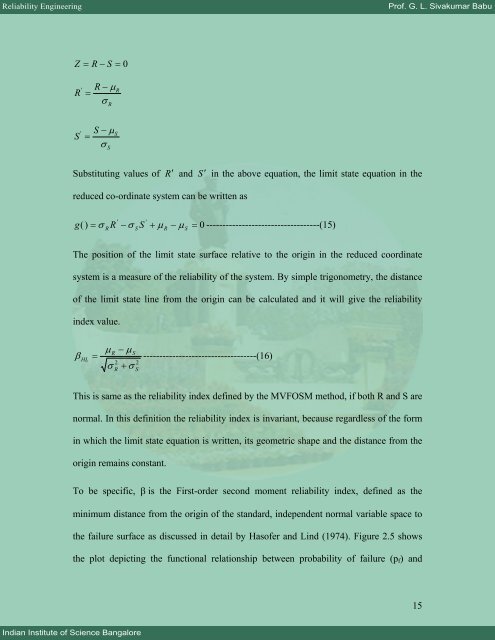Module 5 - E-Courses
Module 5 - E-Courses
Module 5 - E-Courses
You also want an ePaper? Increase the reach of your titles
YUMPU automatically turns print PDFs into web optimized ePapers that Google loves.
Reliability Engineering Prof. G. L. Sivakumar Babu<br />
Z = R − S<br />
= 0<br />
' R − µ R R =<br />
σ<br />
Indian Institute of Science Bangalore<br />
S<br />
'<br />
R<br />
S − µ S =<br />
σ<br />
S<br />
Substituting values of R′ and S′ in the above equation, the limit state equation in the<br />
reduced co-ordinate system can be written as<br />
' '<br />
g ( ) = σ R R −σ<br />
S S + µ R − µ S = 0 -----------------------------------(15)<br />
The position of the limit state surface relative to the origin in the reduced coordinate<br />
system is a measure of the reliability of the system. By simple trigonometry, the distance<br />
of the limit state line from the origin can be calculated and it will give the reliability<br />
index value.<br />
β<br />
µ − µ<br />
R S<br />
HL = -----------------------------------(16)<br />
2 2<br />
σ R + σ S<br />
This is same as the reliability index defined by the MVFOSM method, if both R and S are<br />
normal. In this definition the reliability index is invariant, because regardless of the form<br />
in which the limit state equation is written, its geometric shape and the distance from the<br />
origin remains constant.<br />
To be specific, β is the First-order second moment reliability index, defined as the<br />
minimum distance from the origin of the standard, independent normal variable space to<br />
the failure surface as discussed in detail by Hasofer and Lind (1974). Figure 2.5 shows<br />
the plot depicting the functional relationship between probability of failure (pf) and<br />
15

















